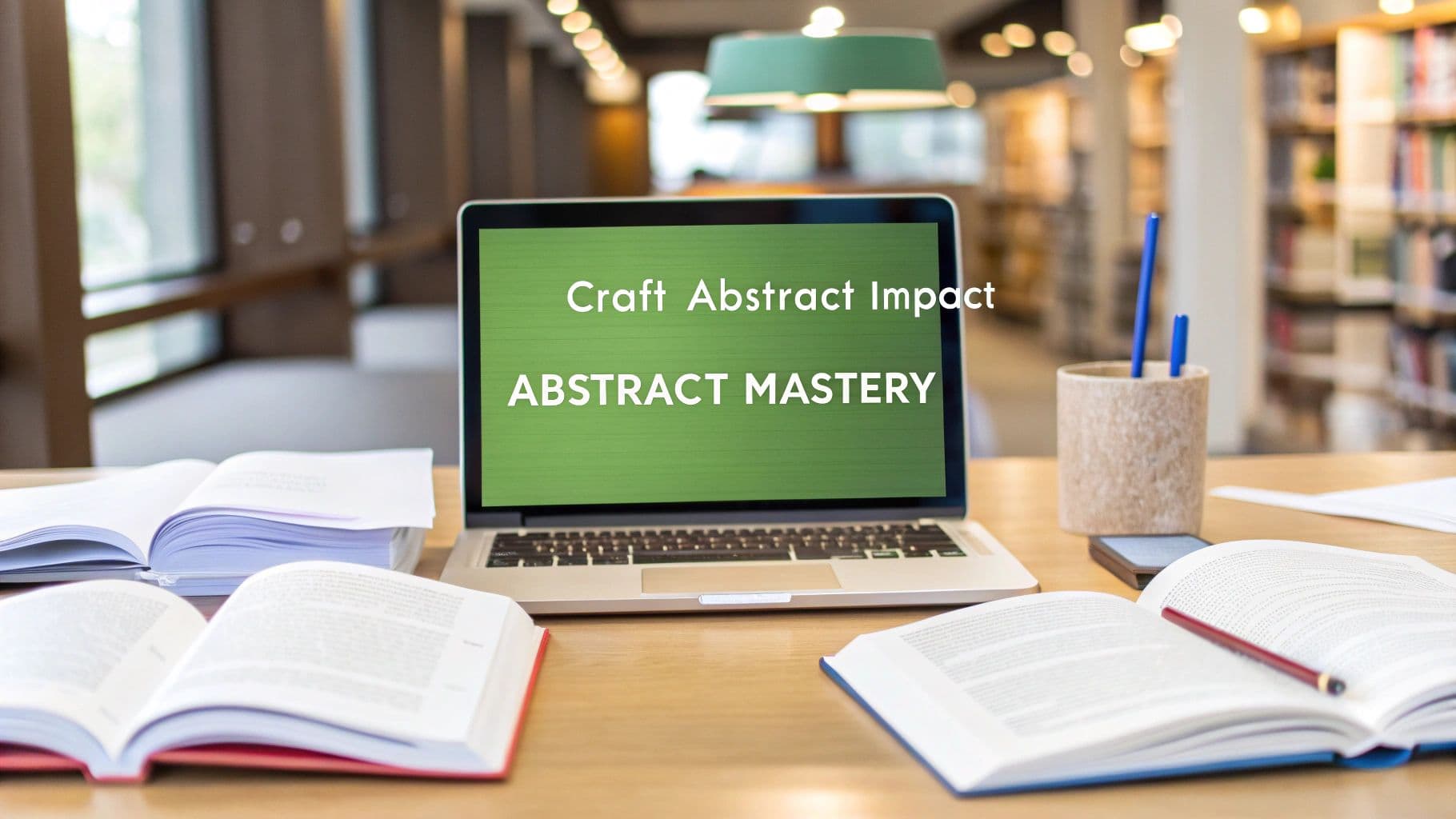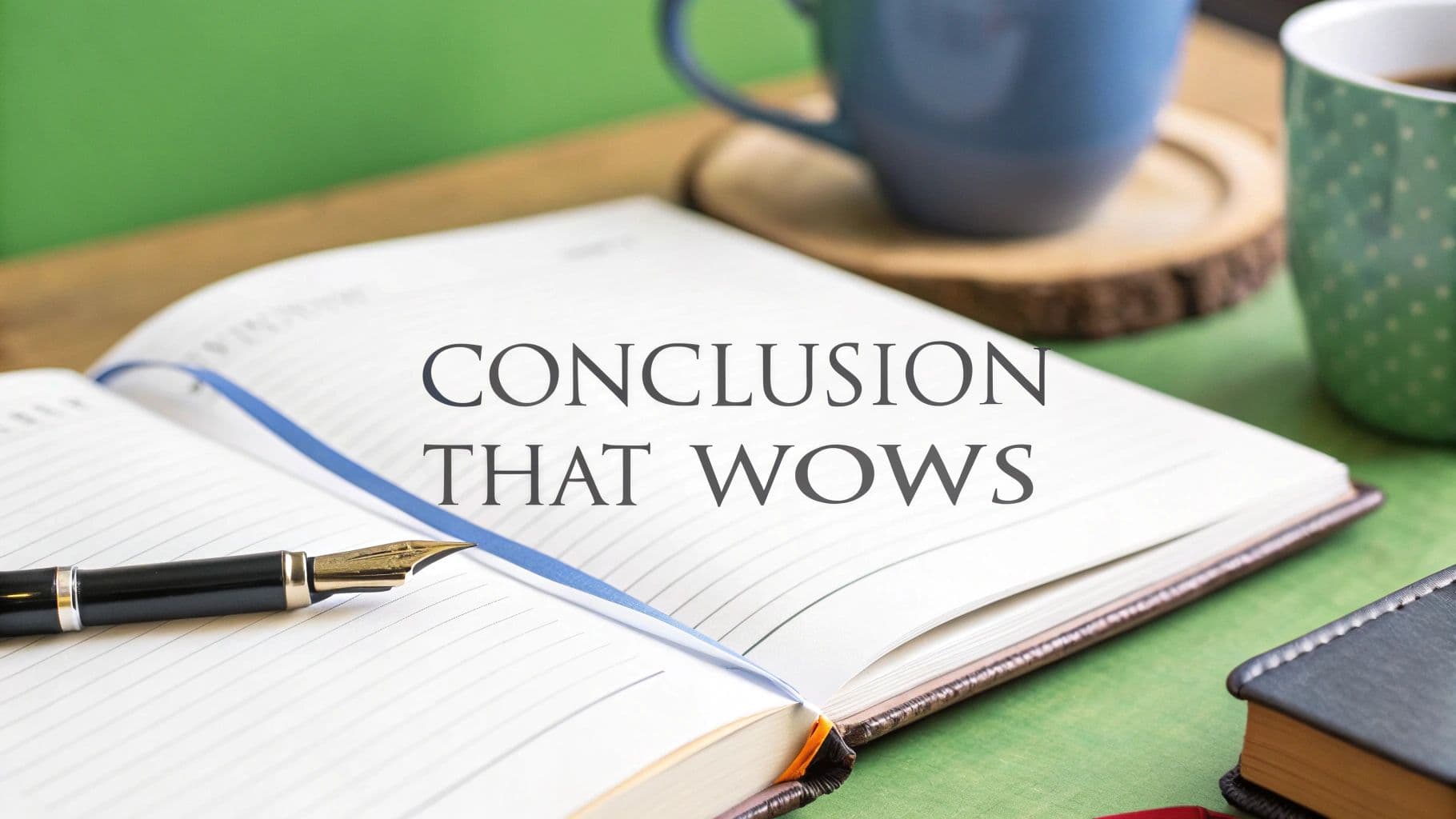
How to Write a Conclusion Paragraph That Wows
August 18, 2025
Ever wondered why some arguments stick with you long after you've finished reading? The secret is almost always in the conclusion. A weak ending can make a brilliant piece of writing fall flat, while a powerful one can elevate the entire thing.
Too many writers treat it as an afterthought—just a quick summary before they can call it a day.
That’s a huge missed opportunity. Your conclusion is your final, compelling argument that proves your point beyond a shadow of a doubt. It’s where you finally answer the reader’s unspoken question: “So what?” By showing them why your ideas matter in the bigger picture, you give your work a sense of completeness and authority.
Frame Your Final Message
A great conclusion doesn’t drop new evidence on the reader. Instead, it re-frames what they already know, connecting the dots to reveal the full picture. It should give them a sense of closure and make them feel like their time reading your work was well spent.
A solid conclusion also helps your readers lock in what they've learned. The goal is to make your main points memorable, which is where understanding some basic strategies for information retention can really give you an edge.
Master the Core Structure
Think of your conclusion as having three key jobs. First, you need to restate your thesis, but in fresh language—don't just copy and paste it. Next, you synthesize your main points, weaving them together to show how they support your central argument. Finally, you leave the reader with a final thought that hints at the broader implications of your topic.
Let's break down exactly what a conclusion needs to accomplish. It's more than just a summary; it's a strategic move to secure your argument's impact.
Key Functions of a Conclusion Paragraph
| Function | What It Achieves | Why It Matters |
|---|---|---|
| Restate the Thesis | Re-presents your core argument in a new, more confident way. | It reminds the reader of the central claim they've been following. |
| Synthesize Key Points | Connects the dots between your main supporting ideas. | It shows how all the pieces of your argument fit together to form a cohesive whole. |
| Answer "So What?" | Explains the broader significance or implications of your argument. | This gives your work meaning beyond the page and leaves a lasting impression. |
| Provide Closure | Signals the end of the discussion, leaving the reader with a sense of finality. | It prevents your argument from feeling abrupt or incomplete. |
By hitting these marks, you create a conclusion that feels both satisfying and authoritative, leaving no doubt in the reader's mind about the strength of your position.
Key Takeaway: Your conclusion is your last chance to persuade your readers. It should leave them with a clear understanding of your main argument and its significance, ensuring your message resonates long after they've finished reading.
When you master how to write a conclusion, you turn a simple ending into a powerful tool that leaves a lasting mark.
The Three Core Elements of a Strong Conclusion
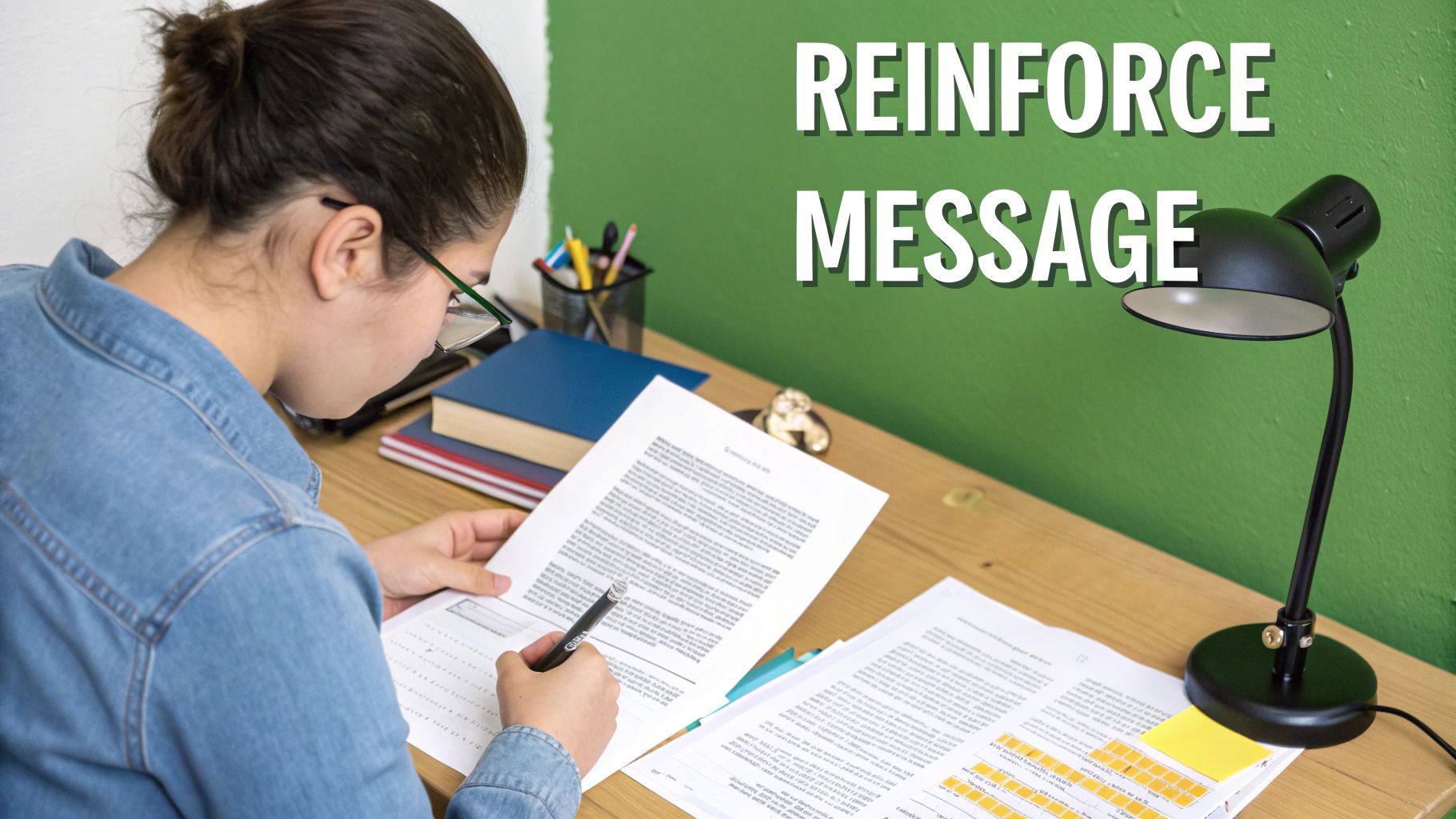
Knowing how to stick the landing with a conclusion isn't about following a rigid formula. It's really about mastering three key ingredients that work together to leave a powerful final impression. Once you get a feel for these, you can wrap up any piece of writing with confidence.
First up, you need a restated thesis. This is not a copy-paste job from your intro. It’s a chance to rephrase your main argument with more authority. You’ve just spent an entire article proving your point, so your restated thesis should sound like it.
Next, you have to synthesize your main points. This is where you connect the dots for the reader one last time. Instead of just listing your arguments again, you want to weave them together. Show how they all built on each other to support your thesis and create a cohesive, undeniable case.
Crafting a Lasting Impression
Finally, every great conclusion needs a concluding thought—what I like to call the "so what?" statement. This is your mic drop moment. It answers the reader's final, lingering question: why did this matter?
What's the real-world significance of your argument? What should the reader do or think about now? This last piece is what elevates your writing from just another article to something truly memorable.
Pro Tip: Your concluding thought should feel like a natural zoom-out from your main argument, not a brand-new idea thrown in at the last second. It's about showing the reader the bigger picture they now understand thanks to your work.
These three parts—the restated thesis, the synthesis, and the concluding thought—are the backbone of any effective conclusion. Getting them right just takes a bit of practice.
Perfecting this skill is a massive part of the revision process. If you want more guidance on refining your entire piece, our writing revision checklist offers practical steps for polishing your work from top to bottom. Each element builds on the last, turning a standard ending into something that sticks with your reader long after they’ve finished.
Building Your Conclusion From the Ground Up
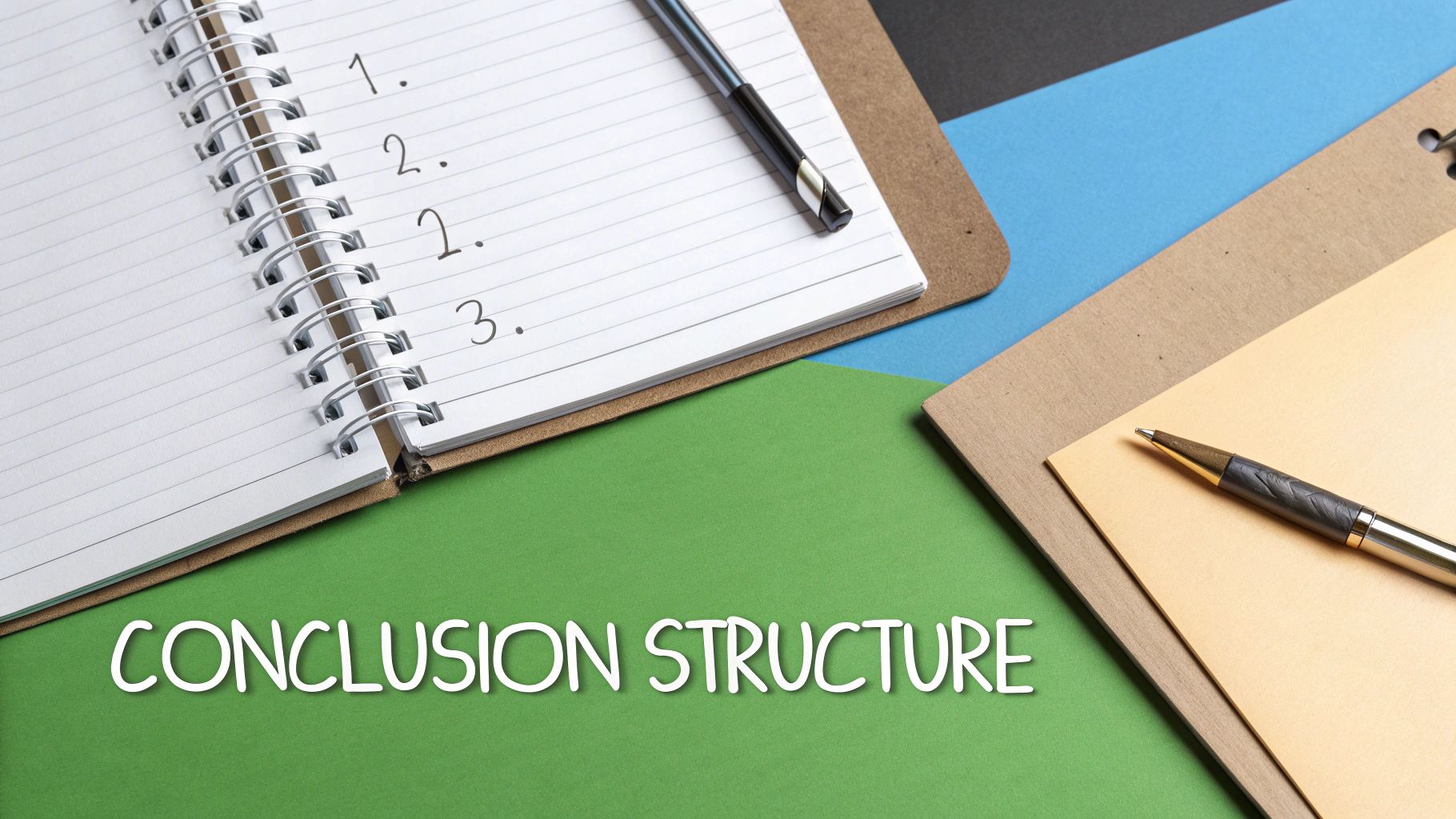
Alright, let's stop talking theory and actually build a conclusion, sentence by sentence. The first thing you need to do? Ditch the stale, obvious phrases.
Starting with "In conclusion" is like announcing the punchline before you even tell the joke. It completely kills the momentum you’ve worked so hard to build.
Instead, aim for a smoother transition that lets your reader know the end is near without being so blunt. You could start with a word like "Ultimately," or even just dive right into your restated main point. The goal is to guide the reader to the finish line, not shove them across it.
Rephrasing Your Thesis
Your next sentence is critical—this is where you bring your main idea back. But don't just copy and paste it from your intro. That's a rookie mistake. After laying out all your evidence and arguments, your thesis should land with more confidence and authority.
Think of it this way: if your original thesis was a proposal, your restated thesis is the final verdict. If you argued that remote work boosts productivity, your conclusion should state it as a proven fact, backed by everything you've just shared.
From there, you’ll want to briefly tie your main arguments together. Don't just list them out again. Show how they connect and support your big idea. Usually, one or two strong sentences are all you need to connect the dots and create a cohesive final thought.
Pro Tip: Keep your conclusion tight. A rambling ending will only dilute your message. Brevity is your best friend when you want to leave a powerful, lasting impression.
Finding the Right Length
So, how long should a conclusion actually be? Most writing experts agree that clarity and brevity are key. The sweet spot is usually around three to five sentences.
That’s just enough space to restate your thesis, summarize your key points, and offer a final thought without repeating yourself or—even worse—introducing new information. It's a concise approach that ensures your ending is memorable and packs a punch.
Of course, mastering conclusions is just one piece of the puzzle. If you're looking to strengthen your writing skills from the ground up, check out this a complete guide on how to start content writing. Nailing the fundamentals is what separates good writing from great writing.
Advanced Techniques to Make Your Conclusion Memorable
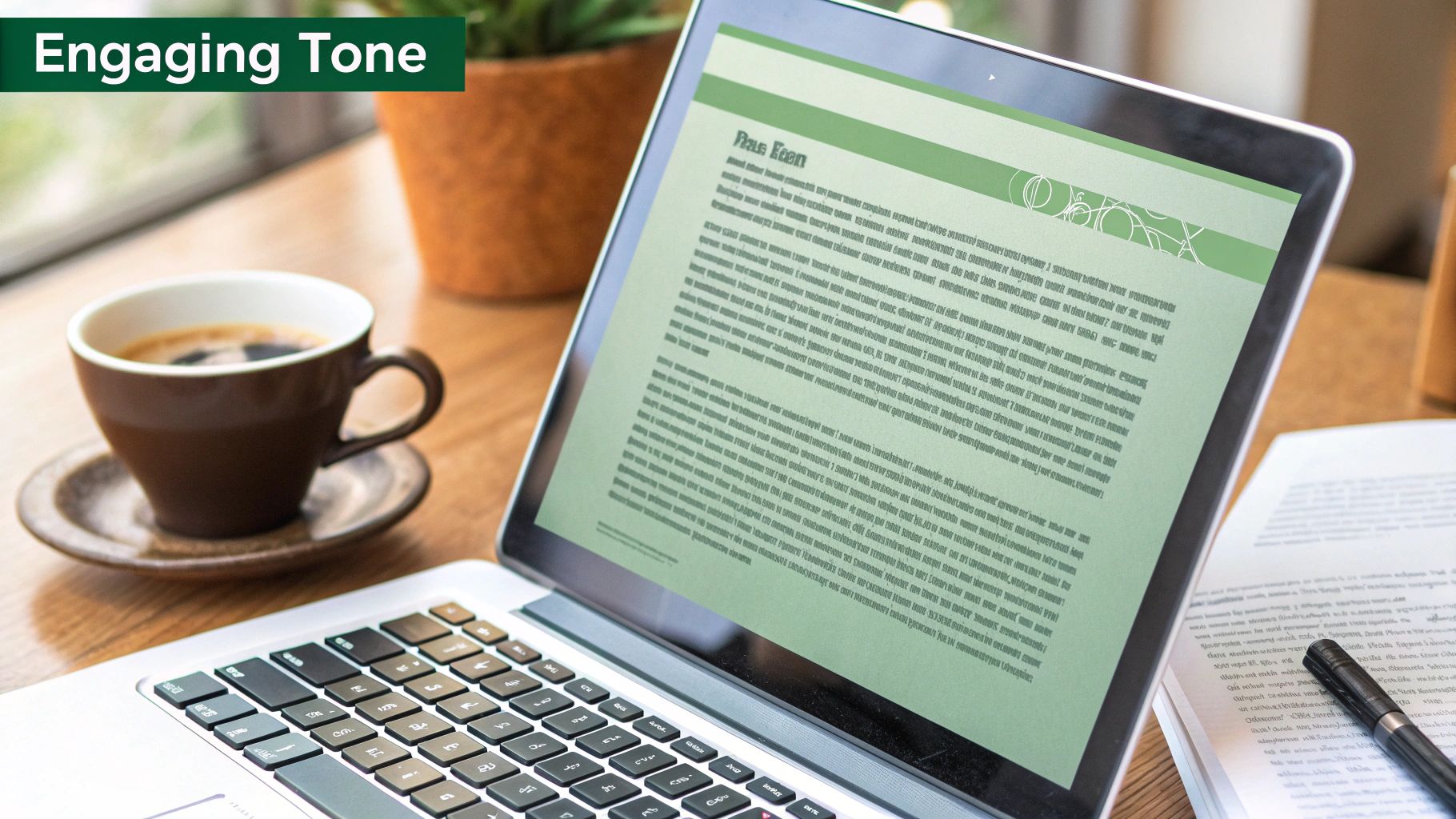
A good conclusion wraps things up. A great one makes your reader think for days.
Once you’ve got the basic structure down, it’s time to move beyond just summarizing. Let’s look at a few ways to craft an ending that really sticks with people, turning a simple sign-off into a powerful final statement.
The goal is to give your reader something to chew on long after they've finished reading.
Go Beyond the Summary
One of the most powerful things you can do is connect your topic to a bigger picture. Show your reader why what you’ve just told them matters in the grand scheme of things.
For instance, if you wrote a paper on historical trade routes, you could end by reflecting on how those old connections shaped modern globalization. This “zooming out” technique gives your work a sense of weight and importance. It makes it feel relevant.
Another approach is to end with a clear, compelling call to action. Don't just inform your readers; give them something to do.
Key Takeaway: The best conclusions give the reader a sense of purpose. Whether it's to reconsider an old idea, explore a new topic, or take a specific action, you're guiding their next step.
This works especially well in persuasive writing. A blog post about environmental conservation could end by challenging readers to adopt one specific sustainable habit. Suddenly, your words have a practical, real-world impact.
Using Questions and Quotes
Ending with a thought-provoking question is a classic move for a reason. It shifts the focus back to the reader, inviting them to keep thinking about the topic on their own terms. The trick is to ask something that doesn’t have a simple answer. You want your ideas to linger.
Alternatively, a well-placed quote can offer a sense of authority and a touch of elegance. Just make sure it directly reinforces your main point and captures the essence of your argument. A random, feel-good quote won't cut it.
Mastering these techniques is all part of the final polish. As you refine your conclusion, you'll find that small tweaks can make a huge difference. For more tips on that last stage of writing, our guide on how to edit a paper can help you sharpen every sentence for maximum impact.
7 Common Conclusion Mistakes to Avoid
Knowing what not to do is just as important as knowing what you should do. You can write a brilliant essay, but if the conclusion falls flat, the whole piece suffers. Let's walk through some of the most common pitfalls I see and how to sidestep them so your final words land with impact.
Don't Introduce New Ideas
This one is huge. The conclusion is for wrapping things up, not for throwing in a last-minute argument or a brand-new piece of evidence. It's a classic mistake that leaves your reader feeling confused and your essay feeling unfinished, almost like you ran out of time or space. Stick to summarizing and synthesizing what you've already discussed.
Don't Just Repeat Yourself
Another frequent error is simply copying and pasting the thesis from your introduction. While your conclusion should absolutely echo your main argument, it can't be a word-for-word repeat. Think of it this way: your reader has just gone on a journey through your paragraphs. Your conclusion needs to reflect that, showing a deeper, more informed perspective on the topic.
Don't Apologize for Your Argument
Finally, avoid weakening your own argument with phrases like, "This is just my opinion," or "I'm not an expert, but..." Have confidence in your work! A strong conclusion feels authoritative and final. It should leave the reader with a clear sense of your position and the strength of your reasoning.
The image below breaks down the key differences between a weak ending and a strong finish.
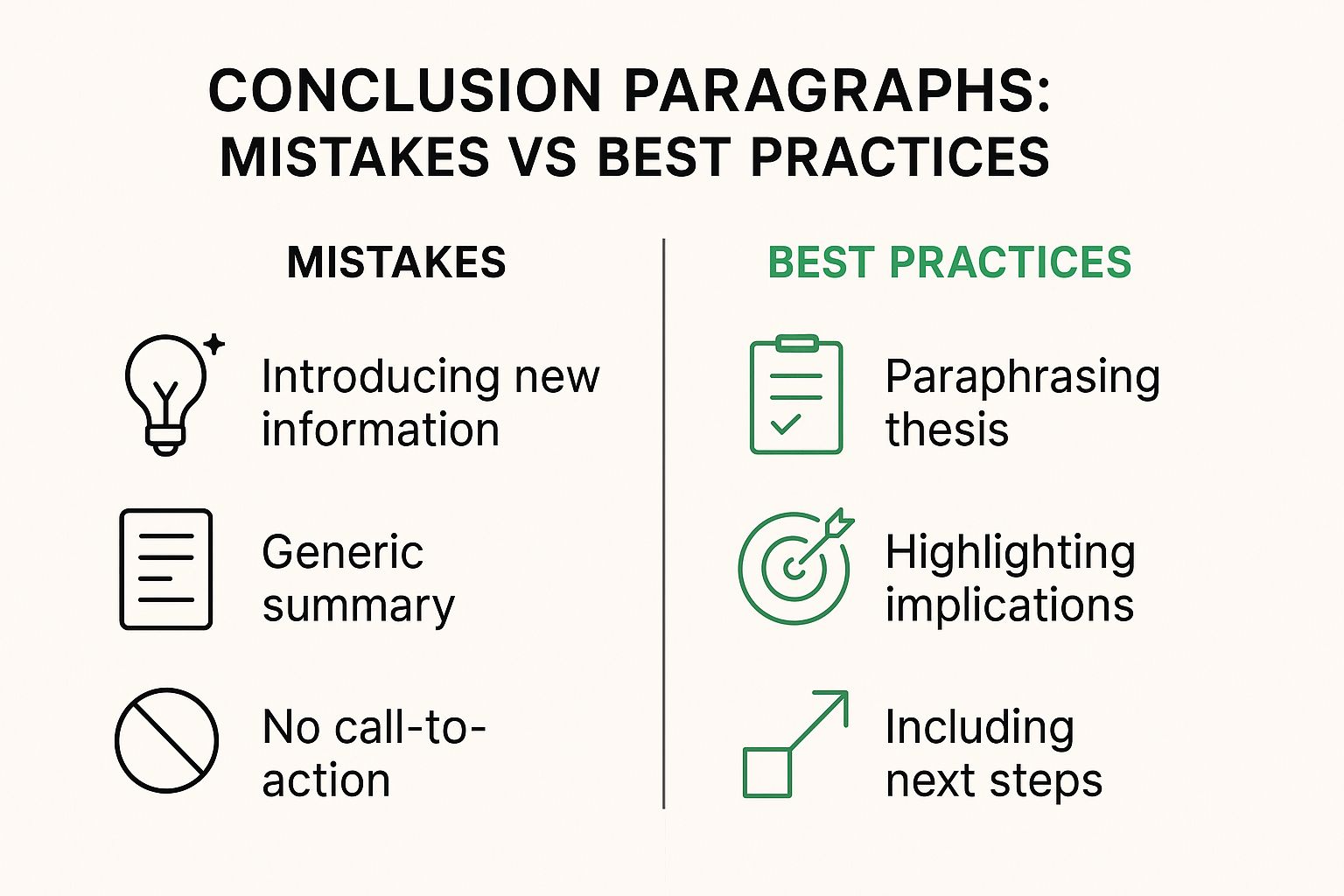
As you can see, the goal is to shift from lazy repetition to thoughtful synthesis. You want to move from a passive summary to an active, engaging final statement that reinforces your message and gives the reader a satisfying sense of closure.
Learning to avoid these common traps is a huge step toward learning how to write better essays with endings that truly resonate.
Avoiding Common Conclusion Pitfalls
To make it even clearer, here’s a quick-glance table comparing common mistakes with stronger, more effective alternatives.
| Common Mistake | Weak Example | Stronger Alternative |
|---|---|---|
| Introducing New Info | "In conclusion, while social media has many downsides, another point to consider is the rise of the creator economy." | "Ultimately, the evidence shows that social media’s negative impacts on mental health demand a more mindful approach to its use." |
| Repeating the Thesis | "To summarize, I have argued that recycling is important for the environment." | "By examining the data on landfill reduction and resource conservation, it's clear that recycling is not just beneficial—it's essential for a sustainable future." |
| Using Apologetic Phrases | "In my opinion, these are just a few reasons why literature is still important today." | "Therefore, literature remains a vital force, shaping our understanding of the human condition in a way no other medium can." |
| Ending Too Abruptly | "And that is why the policy failed." | "The policy's failure serves as a critical lesson in the importance of community involvement for any future legislative efforts." |
Looking at these side-by-side really highlights the difference a few tweaks can make. A strong conclusion doesn't just end the essay; it elevates the entire argument you've just made.
Your Questions on Writing Conclusions Answered
https://www.youtube.com/embed/-sRH2nCH8mg
Even with a solid plan, wrapping up a piece of writing can feel tricky. Questions always seem to pop up right at the end. Let's tackle some of the most common ones writers have about conclusions so you can finish your work with confidence.
Think of this as your quick-reference guide. The goal is to give you clear, no-nonsense answers that get you back to writing a killer ending.
How Long Should My Conclusion Be?
For most articles, essays, or blog posts, the sweet spot is 3 to 5 sentences.
That’s usually enough space to restate your main point, tie your key ideas together, and leave the reader with a final thought—all without dragging things out.
Of course, if you’re writing a massive research paper or a super detailed report, you might need a bit more room. The real key is to stay focused, no matter how long the piece is. Your conclusion should be a powerful summary, not just another body paragraph.
Key Takeaway: Prioritize impact over length. A short, punchy conclusion always beats a long, rambling one that loses the reader at the very last moment.
Can I Use a Quote in My Conclusion?
Absolutely, but you have to be smart about it. A powerful, relevant quote can be a fantastic way to end your piece, as long as it directly reinforces your main argument.
Just don't drop a quote in there to fill space or because it sounds nice. It has to add real value and give your reader a memorable takeaway that perfectly aligns with your message.
What Are Some Good Transition Words?
Moving past stale phrases like "In conclusion" is an easy win to make your writing sound more polished. Stronger transitions signal the end without being so painfully obvious.
Try starting your final paragraph with one of these:
- Ultimately, this shows the final result of your arguments.
- Therefore, this highlights the logical endpoint of your reasoning.
- Overall, this provides a big-picture summary.
You can also create a really smooth transition by just launching right into your rephrased thesis. This approach often feels more natural and less formulaic. When a conclusion is meant to resolve lingering questions, it also helps to explore strategies for effectively structuring answers in an FAQ to make things crystal clear for your readers.
